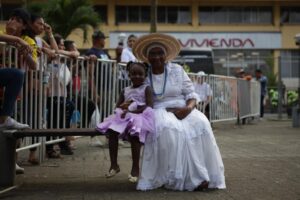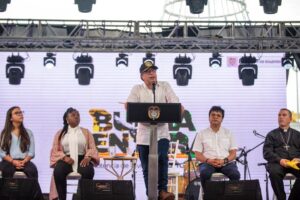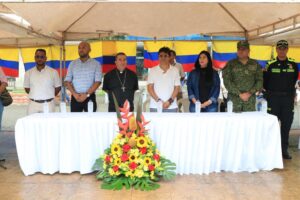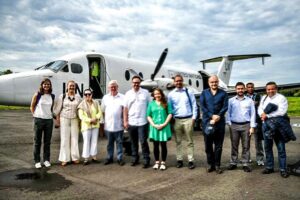
In Buenaventura, the tragedy of Kimberly and Cristian, two nine and seven-year-old children, reveals the relentless pulse of violence that darkens the horizon of this Colombian port. As the search for ‘Total Peace’ progresses, their lost lives stand as symbols of a struggle for reconciliation amid persistent challenges.
By Juan Carlos Díaz
Journalist FORO HUMANOS
Kimberly Quiñones Hinestroza and Cristian Andrés Montaño Hurtado were nine and seven years old, respectively, when fate involved them in a line of terror and violence that seems to wander, destroying innocent lives, completely destroying social processes and perpetuating the shadow of unrest over Buenaventura, the main Colombian port on the Pacific Ocean, which moves 60 percent of this country’s foreign trade.
Both children died from those fatalities of destiny, which, due to the frequency with which they happen, seem to become normalized: a stray bullet took away their lives, their dreams and left a trail of irreparable pain in their families.
The sad reality
Kimberly was shot in the head on July 1, 2023, while she was on the platform of her house playing in the urbanization neighborhood, sector known as R9, of Commune 12 of this Port. She died at the Imbanaco Clinic in Cali (capital of Valle del Cauca and three hours by road from the Port), after fighting for her life for four days.
She had previously been admitted to the Santa Sofía clinic in Buenaventura, but because it is a second level hospital, they did not have the capacity to care for her. For the health personnel of this healthcare center, the fact that the most important port in Colombia only has a second level hospital is also a cause of violence.
During his wake on July 6 at the Los Olivos funeral home, in this Valle District, the Colombian Minister of Defense, Iván Velásquez, together with the commander of the Police, General William René Salamanca and other officials from the military leadership, told him to the mother of the minor, Ingrid Quiñonez, who would guarantee that cases like the one her daughter experienced are not repeated.
Violence that displaces lives
“In 2021 I left Bellavista fleeing the violence of Comuna 7 and the stray bullet that almost killed me. And now that I arrive at the R9 neighborhood, they take my daughter away from me, with the bad luck that she did not survive. “My daughter was killed by this gang war to which they have subjected us,” said the mother of the deceased minor.
But the death of innocent children in this port on the Pacific Sea did not stop there. In the first days of November 2023, the projectile that hit Cristian also hit his head.
The incident occurred when several men fired shots between the Bajo Caldas and Nuevo Amanecer sectors, which are also part of commune 12 of this District on the Pacific Sea.
At the Santa Sofía del Puerto clinic, where the injured minor was transferred, he was declared “brain dead.” Later he was disconnected by his relatives, who, devastated by pain, also decided to leave the territory.
It is not the first time that violence has displaced them. Even their arrival in Buenaventura was the product of armed raids in the López de Micay municipality. They went out in search of tranquility, but found more terror and death.
Socioeconomic context in the Colombian Pacific
And to speak of the Colombian Pacific – which has the greatest biodiversity on the planet – is to speak of a historically poor, marginalized area immersed in a spiral of violence that over the years has caused destruction of the social fabric and uprooting among the population. , mostly black.
With more than 83 thousand kilometers of coastline, the Colombian Pacific is made up of four departments: Chocó, Valle del Cauca, Cauca and Nariño, which includes the cities of Buenaventura, Quibdó, Tumaco, Istmina, Guapi, Barbacoas, Bocas de Satinga and Tadó , where more than one million 500 thousand inhabitants live.
Despite being an area with extensive biodiversity (one of the highest in the world) rich in forests and humid tropical jungles, it suffers from innumerable social problems, ranging from unemployment, lack of permanent drinking water, lack of electricity and violence in all its manifestations and especially used as an exit route for illicit drugs by drug trafficking groups.
The municipality of Buenaventura, located in the department of Valle del Cauca, is the main seaport in Colombia and is one of the ten most important ports in Latin America; It is estimated that it moves more than 53 percent of Colombia’s international trade and is the third most populated city in the department after Cali and Palmira.

The port is located on the shores of Buenaventura Bay in the Pacific Ocean. It is 114 kilometers by road from Cali, which is separated from it by the Western Cordillera of the Andes.
This port, inhabited mostly by blacks, mulattoes, Afro-descendants and Afro-Colombians, coexists with illegal armed actors who fight for control of communities, territories and illegal businesses, causing continuous displacements, massacres and forced disappearances.
Peace initiatives and persistent challenges
Guerrillas such as the National Liberation Army, ELN (which is currently carrying out peace talks with the National government), dissident groups of the Revolutionary Armed Forces of Colombia, FARC (which signed a final peace agreement on September 26, 2016 with the government of President Juan Manuel Santos), drug trafficking gangs from Colombia and Mexico, as well as criminal structures such as «Los Shottas» and «Los Espartanos», added to the Self-Defense Forces, now called “Las Gaitanistas de Colombia”, are the that operate in this area of the Colombian Pacific coast that have put this port in a life of difficulties and uncertainties over the last decades.
It was in Buenaventura – discovered by Mr. Pascual de Andagoya after he left Panama in three boats to explore the Pacific Sea and entered the Bay that was later called Buenaventura – where, after fourteen discreet and private meetings in various places of this port on the Pacific Sea; as well as multiple exchanges of messages via telephone and WhatsApp and tours and walks through neighborhoods and communes of this municipality in the department of Valle del Cauca, an unprecedented urban peace process in the history of Colombia began to ensure that 1,760 young people who found in arms and who are part of the armed gangs called “Shottas” and “Spartans”, which have caused a spill of blood and anxiety in this area of the country, will sit down to talk to seek Total Peace, the banner of the current government of the president Gustavo Petro.
The hope for ‘Total Peace’ in Buenaventura
A month after taking office as the 42nd president of Colombia, Gustavo Petro confirmed that these two groups that dispute the territory sent letters saying that they were willing to seek justice.

The bishop of the port of Buenaventura, Monsignor Rubén Darío Jaramillo, intermediary in this entire pilot peace process that began in July 2022, officially announced on October 18, 2022 the dialogues for Peace between the Colombian government and the armed gangs of “ Shottas” and “Espartanos”, after the first minutes and table were held.
On October 19, 2022, the outgoing Commissioner for Peace of Colombia, Danilo Rueda, announced that the first direct approach was had with delegates from these two Organized Crime Groups, regarding the possibilities of opening a stable and peace-building scenario. lasting in this Port and the guarantees for the parties.
On October 26, 2022, the Colombian Congress approved the Total Peace Law that authorizes President Gustavo Petro to seek a reconciled solution with guerrilla groups and criminal gangs linked to drug trafficking, through negotiation and submission processes. Justice.
Already at that time in 2022, Buenaventura had gone 38 days without reporting homicides, disappearances and confrontations caused by these two criminal gangs and, despite the fact that the Submission Law for criminal groups was still being processed in the Congress of the Republic.

International accompaniment
In this urban peace process in Colombia, there are international guarantors, who provide permanent support to the process and the implementation of what was agreed. Above all, regarding reintegration into civil society, since there are more than 1,700 members of these groups.
And thus began what President Gustavo Petro himself called: “Unpublished episode in the history of Colombia.” A “Total Peace” laboratory in Buenaventura, a Special District made up of almost 25 neighborhoods and about three invasions.

Once Gustavo Petro was inaugurated as president of Colombia and Francia Márquez as vice president, these two illegal armed groups that dispute the territory in the urban area of Buenaventura, on September 9 and 10, 2022, through statements, expressed their intention officially to accept the Total Peace proposal, despite the fact that, in July of that same year, the church was already talking to them so that they would lay down their weapons.
Based on the above, and with the key accompaniment of Monsignor Rubén Darío Jaramillo of the Diocese of Buenaventura, on October 2, 2022, the great sporting event “Buenaventura en Paz” was held in one of the neighborhoods most affected by violence: Juan XXIII of commune 7.
80 days without violence
This is how this port in the Pacific managed to have more than 80 days without violent deaths and will register a 97 percent reduction in homicides.
On December 7, 2022, with the presence of President Petro, the ‘Total Peace’ laboratory proposed by the president began, which would become a model, not only for other regions of the country with high rates of violence, but for Latin America.
Faced with this possibility of dialogue, President Gustavo Petro highlighted that as of today, a path is being opened with different formations, a new and unprecedented experience, because we are talking about the “Shottas” and the “Spartans”, which are organizations of armed young people linked to drug trafficking.
While in 2021, 90% of the homicides that occurred in the urban area of the Port totaled 191, in 2022 the figure was reduced to 111 homicides, that is, 80 less compared to the previous year.
The fragile calm in Buenaventura
But the non-aggression pacts began to be broken. According to records of the Peace and Reconciliation Foundation. Pairs, between January and May 2023, a total of 42 homicides were perpetrated by the action of these two criminal gangs, with May (18 cases) and April (12 cases) being the most serious months.
In May 2023 alone there were 23 confrontations that closed a balance of 48 homicides due to gang confrontations in the first five months of the year.
The Consultancy for Human Rights and Displacement, Codhes, documented that, as a consequence of the clashes between criminal gangs, “of the nine massive and multiple displacement events that occurred in 2023, three were urban in Communes 6 and 7, exacerbated by clashes between the “Shottas” and “Espartanos” gangs and their alliances with the groups “Los Chiquillos” and the “Jalisco Nueva Generación Cartel”.





